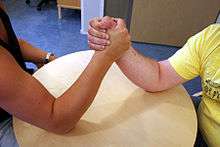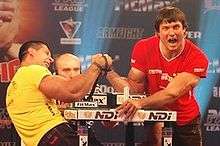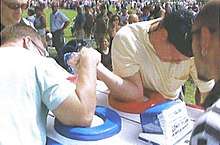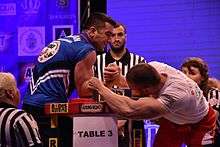Arm wrestling
Arm wrestling (or armwrestling), also known as "armfighting" is a sport involving two participants. Each places one arm on a surface with their elbows bent and touching the surface, and they grip each other's hand. The goal is to pin the other's arm onto the surface, the winner's arm over the loser's arm. In the early years different names were interchangeably used to describe the same sport: "arm turning", "arm twisting", "arm wrestling", "Indian arm wrestling", "twisting wrists", "wrist turning", "wrist wrestling".[1] Organized armwrestling tournaments started being held in the 1950s.
 Two people with their arms in a starting position | |
| Players | 2 |
|---|---|
| Skill(s) required | strength, endurance, technique, resistance |
Description
Various factors can play a part in one's success in arm wrestling. Technique and overall arm strength are the two greatest contributing factors to winning an arm wrestling match. Other factors such as the length of an arm wrestler's arm, muscle and arm mass/density, hand grip size, wrist endurance and flexibility, reaction time, as well as countless other traits, can add to the advantages of one arm wrestler over another. It's sometimes used to prove who is the stronger person between two or more people. In competitive arm wrestling, as sanctioned by the United States Armwrestling Federation (USAF), arm wrestling is performed with both competitors standing up with their arms placed on a tournament arm wrestling table. Arm wrestling tournaments are also divided into weight classes as well as left and right-handed divisions. Furthermore, strict rules such as fouls given to penalties (such as the competitor's elbow leaving a matted area where the elbow is meant to remain at all times, or a false start), and trying to escape a possible arm pin by breaking the grip with the opponent may result in a loss at the table. Paraphrasing USAF rules, arm wrestlers must straighten their wrists without a time lapse of one minute during competition.[2]

The World Armwrestling Federation (WAF) was the universally recognized global governing body of professional arm wrestling and comprises 80 member countries.[3] However, due to the labeling of referees and competitors that were associated with PAL/URPA with the status of "Not in good standing" thus being suspended from WAF[4], many countries are jumping ship.
The International Federation of Armwrestling (IFA) is a democratic non-profit sport organization registered in Zurich, Switzerland and is recognized by TAFISA, the Association for International Sport for All.
Types
- armwrestling
- stand-up armwrestling
- sit-down armwrestling
- wristwrestling
- stand-up wristwrestling
- sit-down wristwrestling
Top Pullers
The armwrestling historian Eric Roussin, founder of The Armwrestling Archives site, has ellaborated a chonology of the top pullers along the history for right hand[5] and left hand[6] pullers. It's based on the results of the major professional events, including sit-down/stand-up wristwrestling and sit-down/stand-up armwrestling.
Men (Right Hand)
In 1966 another organization started to hold World Championships: the International Federation of Arm Wrestlers. Few competitors competed in both, so a parallel ranking was provided. On 1971 both rankings were unified.
| Start Date | #1 Puller | Defeated / (Ahead Of) | Event | Top Spot |
|---|---|---|---|---|
| February 11, 1961 | | California Wristwrestling Championship | 364 days | |
| February 10, 1962 | | Duane “Tiny” Benedix | World Wristwrestling Championship | 364 days |
| February 09, 1963 | | Earl Hagerman | World Wristwrestling Championship | 364 days |
| February 08, 1964 | | Larry Cory | World Wristwrestling Championship | 1 year, 5 days |
| February 12, 1965 | | Joe Schuler | World Wristwrestling Championship | 1 years, 3 days |
| February, 1966 | | Arnie Klein | World Wristwrestling Championship | 1 year, 87 days |
| May 13, 1967 | | Randy Petrini | World Wristwrestling Championship | 278 days |
| February, 1968 | | (Larry Finley) | World Wristwrestling Championship | 2 years, 90 days |
| May, 1970 | | George Witteman | World Wristwrestling Championship | 364 days |
| August 06, 1966 | | Arnie Klein | IFAW World Championship | 2 years, 41 days |
| September, 1968 | | John Torch | IFAW World Championship | 2 years, 241 days |
| May 14, 1971 | | Maurice “Moe” Baker | World Wristwrestling Championship | 1 year, 7 days |
| May 20, 1972 | | Jim Dolcini | World Wristwrestling Championship | 364 days |
| May 19, 1973 | | (Maurice “Moe” Baker) | World Wristwrestling Championship | 364 days |
| May 18, 1974 | | George Ludwigsen | WWC National Championship | 2 years, 194 days |
| November 27, 1976 | | Jim Dolcini | WPAA World Championships | 1 years, 353 days |
| November 15, 1978 | | Virgil Arciero | Supermatch (Las Vegas, USA) | 1 years, 359 days |
| November 08, 1980 | | Cleve Dean | Supermatch (Las Vegas, USA) | 336 days |
| October 10, 1981 | | Virgil Arciero | World Wristwrestling Championship | 1 year |
| October 10, 1982 | | Cleve Dean | AWI Pro Super Heavyweight World Championship | 111 days |
| January 29, 1983 | | Virgil Arciero | AWI Pro Super Heavyweight World Championship | 3 years, 179 days |
| July 26, 1986 | | Cleve Dean | Over the Top World Championship | 1 year |
| July 26, 1987 | | Ed Arnold / (Richard Lupkes) | Over the Top World Championship | 174 days |
| January 16, 1988 | | John Brzenk | Sands International | 266 days |
| October 08, 1988 | | Richard Lupkes | World Wristwrestling Championship | 189 days |
| April 15, 1989 | | John Brzenk | Can-Am Invitational (Barrie, Ontario, Canada) | 1 year, 12 days |
| April 27, 1990 | | Richard Lupkes | Yukon Jack National Championship | 253 days |
| January 05, 1991 | | John Brzenk | Super Bras de Fer (Paris, France) | 204 days |
| July 28, 1991 | | Gary Goodridge | Yukon Jack National Championship | 3 years, 30 days |
| August 26, 1994 | | Gary Goodridge / (John Brzenk) | Yukon Jack National Championship | 16 days |
| September 11, 1994 | | Cleve Dean | WAF World Championships | 348 days |
| August 25, 1995 | | Cleve Dean / (Zaur Tskadadze) | Yukon Jack World Championship | 2 years, 21 days |
| September 14, 1997 | | Ron Bath | USAA National Pro-Am Championship | 7 years, 6 days |
| September 18, 2004 | | John Brzenk | Strong Arm Calling | 49 days |
| November 06, 2004 | | John Brzenk / (Ron Bath) | Nemiroff World Cup | 357 days |
| October 29, 2005 | | Andrey Antonov | Nemiroff World Cup | 35 days |
| December 03, 2005 | | (Andrey Pushkar) | WAF World Armwrestling Championships | 140 days |
| April 22, 2006 | | Farid Usmanov | Ultimate Armwrestling III (Las Vegas, USA) | 2 years, 145 days |
| September 13, 2008 | | John Brzenk | Arm Wars “Deep Water” | 4 years, 262 days |
| June 01, 2013 | | Andrey Pushkar | A1 Russian Open World Armwrestling Grand Prix | 1 year, 55 days |
| July 26, 2014 | | Denis Cyplenkov | A1 Russian Open World Armwrestling Grand Prix | 4 years, 112 days |
| November 14, 2018 | | Tsvetkov, Georgi | WAF World Championship | 1 year, 196 days |
Notes:
Men (Left Hand)
| Start Date | #1 Puller | Defeated / (Ahead Of) | Event | Top Spot |
|---|---|---|---|---|
| September, 1977 | | Dean Christensen | NAWA National Championships | 2 years, 7 days |
| September 22, 1979 | | World Wristwrestling Championship | 7 years, 22 days | |
| October 12, 1986 | | (Canada) | 1 year, 131 days | |
| February 20, 1988 | | Gary Goodridge | Ontario Provincial Championships | 2 years, 243 days |
| October 20, 1990 | | Garvin Lewis | Canadian Stand-Up National Championships | 1 year, 237 days |
| June 13, 1992 | | (Gary Goodridge), (Garvin Lewis) | Gloucester Fair International Armwrestling Championship | 364 days |
| June 12, 1993 | | Steve Morneau | Gloucester Fair International Armwrestling Championship | 364 days |
| June 11, 1994 | | Gary Goodridge | Gloucester Fair International Armwrestling Championship | 364 days |
| June 10, 1995 | | (Steve Morneau), (Gary Goodridge) | Gloucester Fair International Armwrestling Championship | 1 year, 364 days |
| June 08, 1997 | | Mairbek Gioev | Golden Bear International Tournament (Russia) | 180 days |
| December 05, 1997 | | Eric Woelfel | WAF World Championship (India) | 337 days |
| November 07, 1998 | | Alan Karaev | WAF World Championship (Egypt) | 264 days |
| July 29, 1999 | | Vakhtang Javakhadze | European Armwrestling Championships | 1 year, 1 day |
| July 29, 2000 | | Vakhtang Javakhadze | World Armsport Championship | 65 days |
| October 02, 2000 | | Earl Wilson | Canadian Nationals | 336 days |
| September 03, 2001 | | (Earl Wilson) | Harley Pull | 230 days |
| April 21, 2002 | | Cleve Dean | World Armsport Federation World Championship | 165 days |
| October 03, 2002 | | Eric Woelfel | Harley Pull | 65 days |
| December 07, 2002 | | Christian Binnie | All-Niagara Armwrestling Championship | 35 days |
| January 11, 2003 | | Travis Bagent | Reno Reunion Armwrestling Championship | 140 days |
| May 31, 2003 | | Christian Binnie | AAA Nationals | 1 year, 300 days |
| March 26, 2005 | | Sylvain Perron / (Devon Larrat) | Mike Gould Classic | 364 days |
| March 25, 2006 | | Earl Wilson | Mike Gould Classic | 4 years, 264 days |
| December 13, 2010 | | Travis Bagent | Supermatch - Arm Wars “Sin City” (Las Vegas, USA) | 64 days |
| February 15, 2011 | | Devon Larratt | Supermatch - UAL Backyard Brawl | 241 days |
| October 14, 2011 | | Travis Bagent | Nemiroff World Cup | 258 days |
| June 28, 2012 | | Andrey Pushkar | Supermatch - PAL Armfight 42 (Las Vegas, USA) | 2 years, 119 days |
| October 25, 2014 | | Devon Larratt | World Armwrestling League Atlantic City Qualifier | 3 years, 240 days |
| June 21, 2018 | | Andrey Pushkar | Lviv Open Cup | 146 days |
| November 14, 2018 | | Osmanli, Ferit | WAF World Championship | 1 year, 196 days |
Statistics
The following table sumarizes the accumulated time on the #1 spot. John Brzenk and Cleve Dean have been the most dominant pullers with the right hand. Travis Bagent and Cleve Dean have been ruling more time with the left hand. Very few pullers have succeeded to get the #1 spot with both hands for several years: Cleve Dean, Devon Larratt and Gary Goodridge.
(Minimun 4 years with any hand)
| Puller | Height | Weight | Right Hand | Left Hand | Total |
|---|---|---|---|---|---|
| | 6'4" / 1.92 m | 260 lb / 118 kg | 4 years, 88 days | 4 years, 88 days | |
| | 6’0” / 1.83 m | 200 lb / 91 kg | 4 years, 20 days | 4 years, 20 days | |
| | 6’7” / 2.01 m | 460 lb / 209 kg | 5 years, 189 days | 7 years, 22 days | 12 years, 211 days |
| | 6'3" / 1.91 m | 240 lb / 109 kg | 2 years, 225 days | 4 years, 2 days | 6 years, 227 days |
| | 242 lb / 110 kg | 4 years, 242 days | 4 years, 242 days | ||
| | 6'1" / 1.85 m | 198 lb / 90 kg | 13 years, 243 days | 13 years, 243 days | |
| | 6'3" / 1.91 m | 265 lb / 120 kg | 10 years, 350 days | 10 years, 350 days | |
| | 6'4" / 1.92 m | 276 lb / 125 kg | 4 years, 147 days | 258 days | 5 years, 40 days |
| | 6’5” / 1.96 m | 278 lb / 126 kg | 4 years, 262 days | 2 years, 183 days | 7 years, 80 days |
Competitive styles
John Brzenk was known mostly for his array of techniques which change almost every time he engaged in competition, even with the same opponent within the same match. As of summer 2008, John Brzenk was ranked #1 in North America.[7] Ron Bath is known for his use of the Top Roll technique which emphasizes a 'roll' of the wrist as he brings the opponent's wrist down. Devon Larratt is very well known for his endurance and tenacity. He uses a wide array of techniques during his matches, one of them being holding the first "hit" of his opponents and draining them out, and then counter attacking afterwards. He was the 2017 WAL (World Armwrestling League) Heavyweight champion left and right handed. Travis Bagent, like Brzenk, was known for his wide array of techniques, coupled with his massive strength and explosive style. Many of Bagent's matches have ended in seconds. Bagent was considered the best left-handed arm wrestler in the world and ranked second overall in North America, as of summer of 2008.[8]
Other competitors such as Matt Girdner, Michael Selearis, Sean Madera, Marcio Barboza, Christian Binnie, and Anthony Macaluso are known for their reliance on strength, coupled with the hook technique, where the wrist turns into a hooked grip after the referee has started the match. "The hook" or "hooking" is any move derived from the inside system of arm wrestling. The second generic system or style of arm wrestling is known as outside arm wrestling "the top roll" or "top rolling", while the "triceps press", "shoulder pressing", or "shoulder rolling" is often described as the third generic system or style of arm wrestling. Certain arm wrestlers depend on the straps, such as Jason Vale, who won the 1997 Petaluma World Championships in the super heavy weight class at only 175 pounds using the strap technique.

Many arm wrestlers will have a signature style or favorite technique, while others have enjoyed success by becoming extremely well rounded. Within each of the three broad technical systems of arm wrestling there are numerous clearly identifiable techniques which have been developed and enhanced over time. Great Britain's most successful arm wrestler and former two time European and World Middleweight Champion Neil Pickup is one of today's leading arm wrestlers, widely recognized as having originated and developed techniques to suit the genetic make up of individual arm wrestlers. Neil Pickup has enjoyed an amateur and professional career spanning more than 20 years, during which time he has won more than 60 International titles across five different weight classes on both his right and left arms. He has also trained numerous world champions, both male and female. This success has been largely attributed to his technical prowess, experience, and understanding of the athlete's whole body as a lever. He now also hosts a podcast for the WAL.[9]
Common rules
The rules and regulations for arm wrestling are designed to create an even playing field and also prevent broken bones. Different leagues have their own variations, but most use the same table specifications.[10] Below are some of the general arm wrestling regulations:
- The shoulder of both players must be in a square position before the match starts.
- All starts will be a “Ready…Go.” The cadence will vary.
- Competitors must start with at least one foot on the ground. After the “go” players may have both feet off the ground.
- Opposite hand must remain on the peg at all times.
- A pin cannot be made if the elbow is out of the pocket.

- To make a winning pin player must take opponent's wrist below the plane of the touch pad. -This is not true. Any part of the wrist or hand (including fingers) below the pin line or touch pad is enough
- A false start is a warning. Two warnings equals a foul.
- Competitors will forfeit the match with a second foul.
- If opponents lose grip with one another, a strap is applied and the match is restarted.
- Intentional slip-outs are fouls, which occur when both player’s palm completely loses contact with competitor’s palm.
- Competitors may not, at any time, touch their body to their hand.
- Shoulders may not, at any time, cross the center of the table.
- The competitors will always conduct themselves in a sportsperson-like manner while at the tournament.
- The most important arm wrestling rule is the referee’s decision is final.
Training
There are many resources available to help you train for the sport of armwrestling.[11] The best way to get involved in the sport is to find a local club and join their team. Many times they will have experienced competitors that will help you learn how to stay safe on the table, as well as techniques to help you succeed. There are many local tournaments throughout the U.S. that offer novice and/or amateur divisions for those just getting involved.[12]
Associated injury

Arm wrestling puts enormous torque/torsion stress on the upper arm's humerus bone to a degree seen in few other physical activities.[13] Most people's bones are not accustomed to being significantly stressed in this direction, and severe injuries can occur. The arm typically fails because of a diagonal break at or below the midpoint between the shoulder and the elbow; this is known as the 'break arm' position. The most common injury is the humeral shaft fracture. Other common injuries also include shoulder injuries, muscle strain, golfers elbow, and less commonly pectoralis major rupture.
Major organizations
- Arm Wrestling International (AWI)
- International Federation of Arm Wrestlers (IFAW) - held armwrestling tournaments in conjunction with major International Federation of Body Builders (IFBB) bodybuilding contests, including early editions of the Mr. Olympia
- International Federation of Armwrestling (IFA)
- International Wristwrestling Club (IWC)
- Professional Armwrestling League (PAL)
- Bulldog Armwrestling
- Ultimate Armwrestling League (UAL)
- United States Armwrestling Association (USAA) - hosts 25+ U.S. events annually, including the Arnold Classic Armwrestling Challenge in Columbus, Ohio.
- World Armwrestling Federation (WAF)
- World Armsport Federation
- World Armwrestling League (WAL)
- World Professional Armwrestling Association (WPAA)
- World Professional Wristwrestling Association (WPWA)
- World’s Wristwrestling Championship, Inc. (WWC) - first armwrestling organization, organized the first World’s Wristwrestling Championship - it was held in Hermann Sons Hall: the second largest auditorium in Petaluma in 1962; later those (WWC's) World championships were known as Petaluma World’s Wristwrestling Championship [14]
- Carling O’Keefe World Armwrestling Championship - Fred Salvador first organized in 1971 after Petaluma Worlds Wristwrestling Championships; later referred to as the birth of organized armwrestling in Canada; also known as Timmins Worlds
In popular culture
- In the episode "Dead Lift" of the series The Streets of San Francisco (first broadcast May 5, 1977), where Arnold Schwarzenegger plays an important role, we can see his friend Franco Colombu, himself a high-level bodybuilder, and also at the time competitor of athletic strength and contests of "strong men", make a showdown in a bar.
- At the beginning of the film Predator (1987), the characters played by Arnold Schwarzenegger and Carl Weathers improvised a showdown after a vigorous handshake.[15]
- The film Vendetta dal futuro (1986) features arm wrestling.
- The film Over the Top (1987) features a wrestling champion, played by Sylvester Stallone.
- The film Addams Family Values (1993) opens with a showdown between Gomez and The Thing.
- The Fly (1986 film) features an arm wrestling scene in which one of the individual's arms suffers a compound fracture.
- In the episode of The Simpsons "Marge's Son Poisoning" (2005), Homer enters an armwrestling tournament.
- The documentary Pulling John (2009), focuses on the battle for pre-eminence between heavyweights John Brzenk, Travis Bagent and Alexey Voevoda.[16]
- The reality TV show Game of Arms (2014) showed teams of American competitors sacrificing everything to become the nations best armwrestler.[17]
- In Italy, the term used for arm wrestling is braccio di ferro, and the famous cartoon character Popeye is also called Braccio di Ferro.
- The term "Chinese Arm Wrestling" is sometimes used to refer to a battle of inches.
See also
- Alexey Voyevoda
- Ion Oncescu
- John Brzenk
- Heidi Andersson
- Game of Arms, a television series about arm wrestling
- Over the Top, a 1987 film, starring Sylvester Stallone, about arm wrestling
References
- http://armwrestlersonly.blogspot.com/2013/09/champion-armwrestlers-of-yore.html
- WAF/USAF - Armwrestling Rules
- WAF MEMBERS. World Armwrestling Federation
- XSportNews. "WAF Executive Board bans PAL / URPA Events • ARMWRESTLING • ARMWRESTLING NEWS XSPORTNEWS.COM". ARMWRESTLING NEWS XSPORTNEWS.COM. Retrieved 2020-02-26.
- Chronology of the top armwrestlers of the planet (right arm), retrieved 2020-05-29
- Chronology of the top armwrestlers of the planet (left arm), retrieved 2020-05-29
- "Chronology of the Best Armwrestlers on the Planet (Men - Right Hand)". THE ARMWRESTLING ARCHIVES. Retrieved 2020-02-26.
- "Chronology of the Best Armwrestlers on the Planet (Men - Left Hand)". THE ARMWRESTLING ARCHIVES. Retrieved 2020-02-26.
- "Podcasts – Armfighter.com". Retrieved 2020-02-26.
- "Regulations – Armfighter.com". Retrieved 2020-02-26.
- "Training Information – Armfighter.com". Retrieved 2020-02-26.
- "Event Calendar – Armfighter.com". Retrieved 2020-02-26.
- BJSM - Sign In Page
- https://www.thearmwrestlingarchives.com/worlds-wristwrestling-championship---part-2-1962-1969.html
- Guile's Theme Goes with Everything (world's most epic handshake)
- Pulling John, retrieved 2020-02-26
- Game of Arms, retrieved 2020-02-26
External links
| Wikimedia Commons has media related to Arm wrestling. |
- Armfighter.com - The ULTIMATE armwrestling resource.
- Armwrestling news & more…
- New York Arm Wrestling
- Multi-language page with arm wrestling information
- Official page of The Ultimate Arm Wrestling League
- Arm Wrestling World Wide
- Official page of the Pro Arm Wrestling Super Series
- IronArm.net - WAF arm wrestling table specifications
- Are People With Shorter Arms Better Arm Wrestlers?
- Official page of the College Arm Wrestling League
- Official Website of Pakistan Armwrestling Federation (P.A.F)